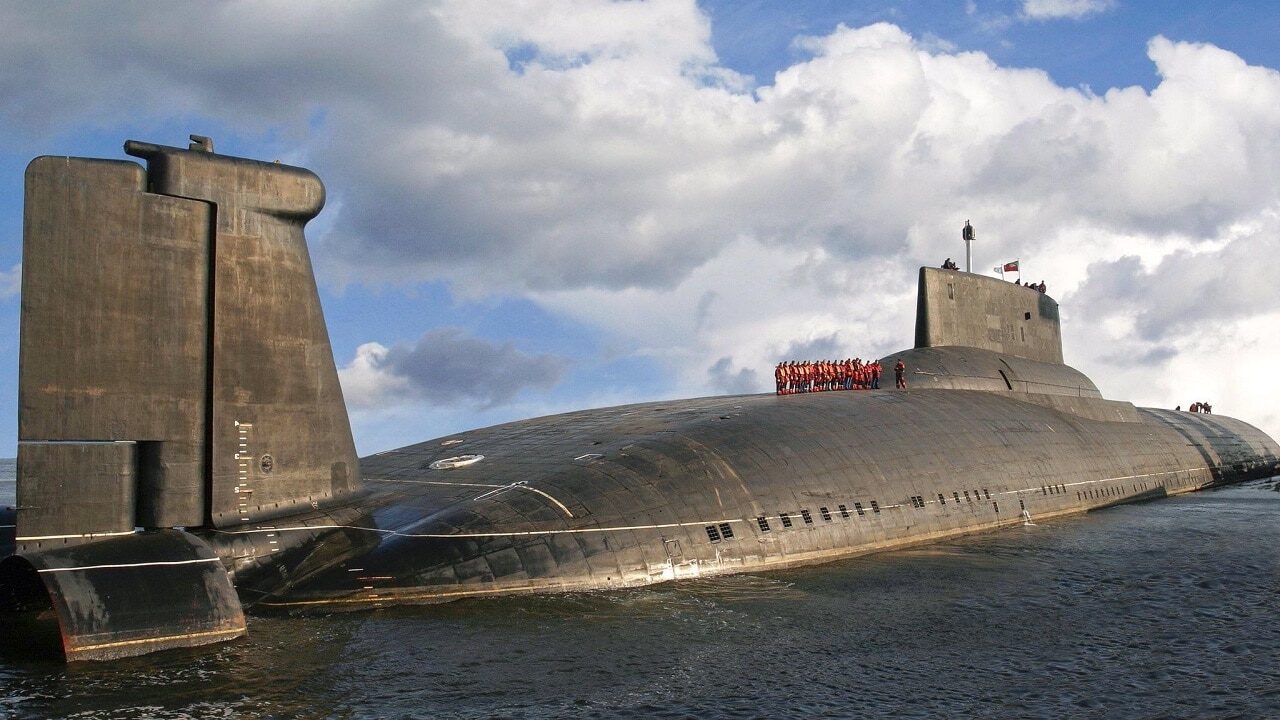The Typhoon had one specific job: To Wage a nuclear war against NATO and the US – Just before Christmas last year, the Russian Navy celebrated the 40th anniversary of the commissioning of the Dmitriy Donskoy (TK-208), the lead boat in the Project 941 Akula (NATO reporting name Typhoon) class of nuclear-powered ballistic missile submarines designed and built for the Soviet Union in the 1980s. A total of seven of the submarines were planned, while six were completed.
With a displacement of 48,000 tons, a length of 175 meters (nearly 600 feet), a 23-meter beam, and a 12-meter draught, these were the largest submarines ever built. Developed with multiple pressure hulls, including five inner hulls situated inside a superstructure of two parallel main hulls, the Typhoon-class was also wider than any other submarine ever built.
Each contained nineteen compartments, including a strengthened module, which housed the main control room as well as an electronic equipment compartment above the main hulls and behind the missile launch tubes. It even was reported that there was a sauna on board as well as a small swimming pool for the crew. The sheer size of the submarines was likely welcomed by the approximately 160 sailors who called the submarine home on voyages lasting 120 days or longer, oftentimes without surfacing for months at a time.
The Typhoon-class subs were designed to counter the United States Navy’s Ohio-class subs, which were capable of carrying up to 192 100-kiloton nuclear warheads. By contrast, the Soviet Typhoons could carry a primary cache of 20 RSM-52 SLBMs (submarine-launched ballistic missiles), each of which contained up to 10 MIRV (multiple independently targetable reentry vehicle) warheads.
The submarines were powered by OK-650 pressurized-water nuclear reactors, two 50,000 horsepower steam turbines, and four 3,200 KW turbogenerators and this provides the boat with the ability to sail at a speed of up to 22.2 knots on the surface and 27 knots whilst submerged.
The Soviet Shark and Russian Prince
The Project 941 Akula – Russian for “Shark” – was developed specifically for operations with the Soviet North Fleet in the Arctic ice packs.
The lead vessel of the class was completed in December 1981, with TK-208 entering service the following year. She was named Dmitriy Donskoy, in honor of the 14th century Prince of Moscow and son of Ivan II the Fair. The first ruler of Moscow to openly challenge Mongol authority, Saint Dmitry Ivanovich Donskoy later oversaw the early construction of the Moscow Kremlin.
It is notable that the first boat of the class is still in service, albeit as a weapons test platform, as she was designed for a ten-year lifetime between major refit. However, she began a 1992 modernization following the dissolution of the Soviet Union, but then spent most of the 1990s in dry dock in Severodvinks due to economic and technological problems.
In its current configuration, Dmitriy Donskoy is equipped with 20 launchers for the Russian RSM-56 Bulava ballistic missiles. One of the missiles was reportedly launched from a submerged position while on the move. It is also equipped with six 533mm (21in) torpedo tubes and type 53 torpedoes.
As with the other boats of the Typhoon-class, TK-208 could work at depths before 400 meters and travel at speeds in excess of 27 knots. The class was designed with an advanced stern fin with a horizontal hydroplane fitted after the boat’s screws, while the nose horizontal hydroplanes in the bow section were designed to be retractable into the hull.
The Russian Navy, which faced funding issues throughout the 1990s, withdrew three of its Typhoon-class submarines by the late 1990s, including one that was scrapped with financial support from the United States. Two more – Arkhangelsk and Severstal were decommissioned by 2013, and the class has been replaced with the smaller Borei-class submarines.
Now a Senior Editor for 1945, Peter Suciu is a Michigan-based writer who has contributed to more than four dozen magazines, newspapers and websites. He regularly writes about military hardware, and is the author of several books on military headgear including A Gallery of Military Headdress, which is available on Amazon.com. Peter is also a Contributing Writer for Forbes.

